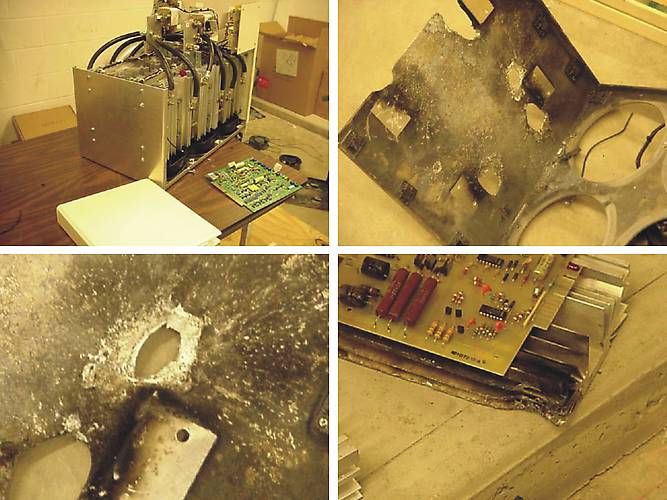When MOVs (Metal-Oxide Varistors) go bad
By Steve McCollum; posted January 22, 2010
View Original: Click to zoom, then click to magnify (4052 x 3039) 4334KB

|
Looking at the first picture, the MOV (Metal Oxide Varistor) is the red disc-shaped item above the heat sinks in this assembly. Most surge protectors contain MOVs (Metal Oxide Varistors). These gizmos act like an open switch until the voltage applied to them exceeds their design threshold, then they conduct in an attempt to shunt the over voltage to ground. The problem is, they cannot handle a lot of current, and each protection event, if the current is sufficient, does some damage to the device itself. After enough events, the MOV will fail and leave you with no protection. But an MOV can fail catastrophically if there is no current-limiting fuse in series with it. And if a current-limiting fuse blows, it will let a serious voltage peak go undamped. It's a real Catch-22. The worst MOV failure I ever saw was in a 1,000 KW UPS in a large data center. This machine had a major design flaw. It had a number of hockey puck style triacs clamped between heat sinks. The heat sinks were mounted off the chassis with standoff insulators. An MOV was installed between each heat sink and the chassis, ostensibly to knock off any peaks that might damage the triacs. Unfortunately, during a transient caused by bringing the UPS online, an MOV failed catastrophically. It literally vaporized, and the metallic ion vapor from it then struck up an arc between the heat sink and chassis. That started a dandy aluminum fire inside the machine. Worse, the inline fuses "protecting" the 480 Volt battery bank did not open fast enough to protect the batteries from the fault current. One of the 200 Ampere-Hour cells exploded, probably because of internal overheating and hydrogen gas liberation, throwing acid and battery debris all over the place. Big gel cells don't appreciate what amounts to a dead short circuit. There is no substitute for a transformer with a big core to block an over voltage peak if the peak has a nice sharp edge like induction from a nearby lightning strike. Anything much above 60 Hz just can't get past. Couple that with some fast-acting fuses to open the circuit in case of a serious over voltage at 60 Hz, and varistors or a spark gap to knock the top off the peaks, and you're pretty well set. Always remember that MOVs are sacrificial. Some devices have an indicator to show that the MOVs are at end of life. But without fast-acting fuses to limit over current, the MOVs will either blow or vaporize. |